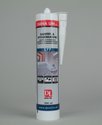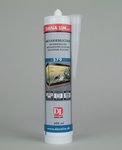 Thomas Therkildsen – Technical Service
Thomas Therkildsen – Technical Service
Dana Lim’s technical service receives a daily stream of inquiries from tradesmen and private individuals who need advice and guidance in connection with the use of products or problems in a given grouting project. Here we give you the most frequently asked questions and answers.
� Can you paint over the joint?

Traditional silicone sealants cannot be painted over, and you will find that the paint “beads off” or flows together without covering. Instead of silicone sealant, you can use MS and PU sealants, which can almost always be painted over. They are available in different hardnesses and elasticity and can be used wherever you want a joint that can be painted over. We would suggest a product such as MS Byggefuge 522 . However, it is important to use a water-based paint with the right elasticity, so that the paint does not crack when moved. Avoid turpentine paints, as these do not dry!
� Which sealants are best for soundproofing?
Gypsum board constructions are often used for sound insulation, because they have a high density and the material itself dampens sound. In addition, they can be built as double constructions. In order to achieve soundproofing, however, the joints to adjacent constructions (walls, attic and floor) must also be tight. For sound insulation, we recommend using acrylic sealant in a joint width of approx. 10 mm, e.g. Acrylic sealant 504 or -557.
� How long should the grout cure?
When it comes to curing, there is never an exact answer! It depends on factors such as: On which material is the joint applied? And what is the temperature and humidity in the room? Acrylic joints (water-based) harden faster at low humidity, while silicone, MS or PU joints harden faster in high humidity. The humidity in a room can be increased using a water atomizer.
� How is the joint cleaned?

Acrylic joint compounds can over time tend to become slightly greyish, and some even yellowish on the surface. It is recommended to use an ordinary soap solution to clean the joints, but in case of strong discolouration, repainting may be necessary. When cleaning windows and doors, it is obvious to dry the sealant at the same time, so that the surface is continuously cleaned. It is also recommended to use a soap solution for this. After cleaning, it is essential to wipe the joints with a clean, wet and lint-free cloth. SMP Interiørfuge 521 is one of our most “clean” joints. It is very soft and dry on the surface, which makes it extremely dirt-repellent, so the joint always appears clean and beautiful.
� Maintenance of joints?

To ensure the longest possible service life of wet room joints , they should not be horizontal as far as possible. They must be cleaned regularly and wiped clean of water and soap residues. The best conditions are found in well-ventilated rooms. Acrylic joint compounds, on the other hand, cannot withstand constant water exposure, but require regular cleaning as mentioned above. If cleaning agents are used, pay attention to the compatibility with the other materials – in case of doubt, a test should be carried out.
� Which joint is best suited for natural stone?
Jointing of natural stone such as granite, marble and slate can give rise to discolouration of the stone to varying degrees. It is therefore important to choose a sealant that both adheres sufficiently and is chemically neutral in relation to the stone. For grouting on marble and granite, e.g. Danaseal Universal 510 , Vådrumssilicone 512 or the neutral curing Danaseal FDA 511 .

� Best suited joints for wet rooms?
For joints in wet rooms, there are extra high requirements for resistance. Therefore, a silicone sealant such as e.g. Sanitet- & Byggesilicone 577 or Vådrumssilicone 512 , both of which contain fungicides – that is what makes them particularly suitable.
� What is acid-free silicone?

The term “acid-free silicone” covers the curing systems used in silicone sealants. Some individual types thus harden by splitting off small amounts of acetic acid, and therefore have a pungent smell while they harden. These are Aquarium Silicone 579 , Silicone A 571 and Glass Silicone 517 . When they are cured, however, they are completely odorless.
Dana Lim’s technical service is of course always ready to provide advice and guidance. Our technicians also recommend that users always read the product’s attached data sheets, where you can find relevant information on areas of application, cleaning, hardening and much more.
Do you have any questions? Then contact Technical Service on tel. 56 64 00 75 or send an email to tekniskservice@danalim.dk . Mon-Thurs: at 08.00-16.00, Fri: at 08.00 – 15.00

